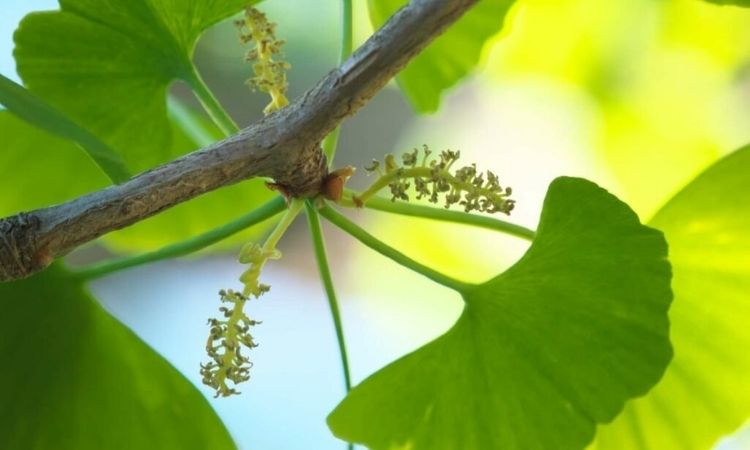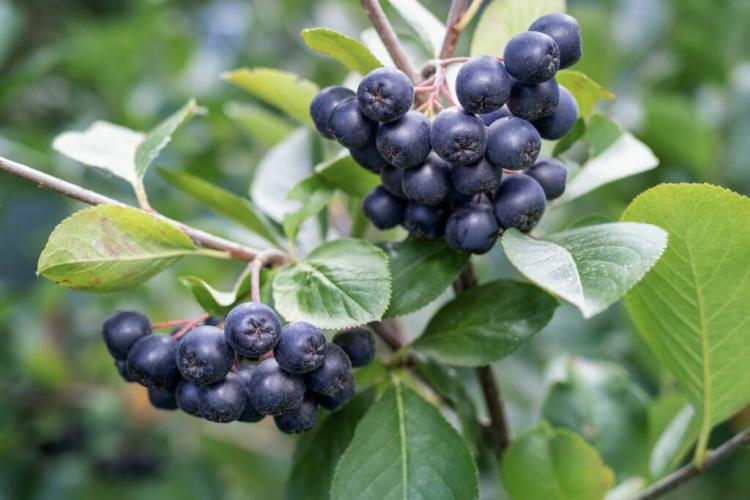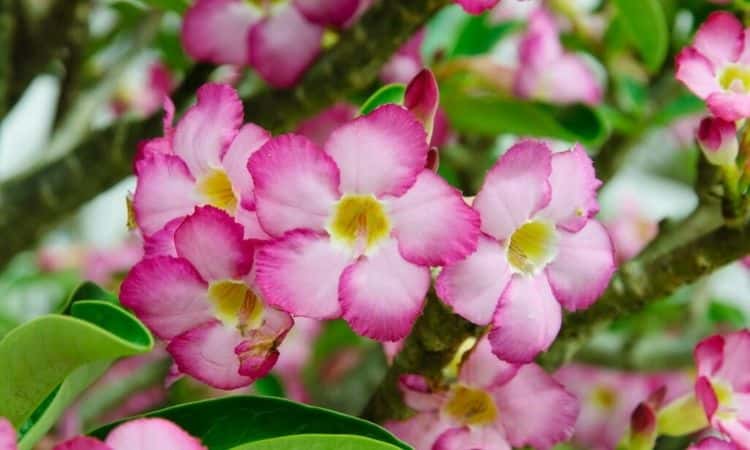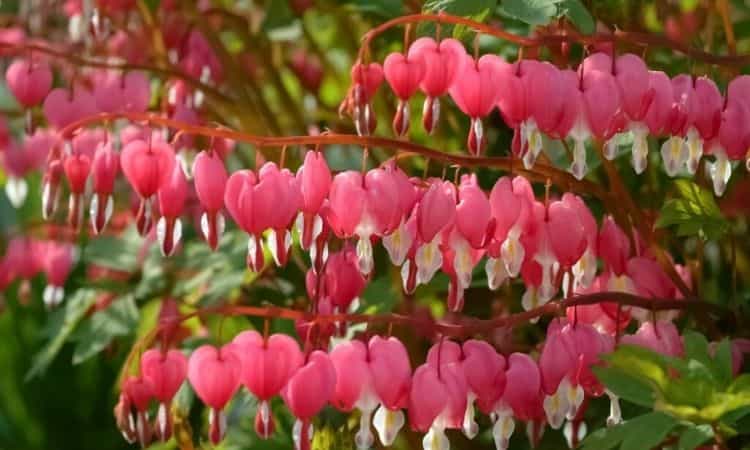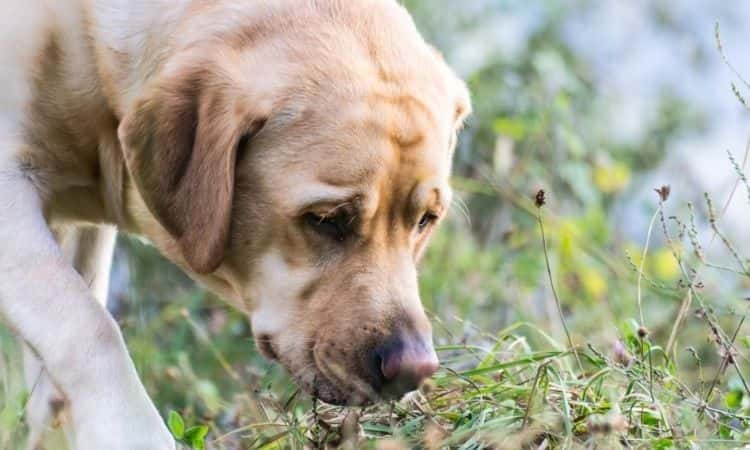Ginkgo (Maidenhair Tree): Infotmations About Tree And Fruits
The Ginkgo (Maidenhair Tree) is one of the oldest tree species on the planet and is also called a “living fossil”. Where the ginkgo tree comes from and how to cultivate it you can learn from us. The Ginkgo occupies a very special position within the plants because it belongs neither to the conifers (conifers) nor to the deciduous trees. We present the primeval plant and give tips on planting, care, and use of the ginkgo tree.
Ginkgo: Flower, Leaf, And Properties
Table of Contents
Already 250 million years ago the Ginkgo (Ginkgo biloba) developed in the primeval forests of the Permian. It should last still further 100 million years until the first deciduous trees developed. Unlike many tree species that are extinct today, the ginkgo survived the era of the dinosaurs, the development of the first birds, and was still widespread in Central Europe about 30 million years ago. The ice age finally pushed the primeval tree away to warmer regions in China. There, botanists and plant lovers discovered the ginkgo tree and again spread it worldwide. It is the only living member of the ginkgo family (Ginkgoaceae). Therefore, there is no selection of ginkgo species, but there are some ornamental forms and varieties.
Ginkgos reach medium-sized trees with a growth height of 49 – 90 ft and grow 32 – 49 ft and more in the width. It gains about 13 – 15 inches in height per year. The bark is gray-brown and strongly grooved, the wood of the ginkgo is light yellow. Due to the conspicuous leaves and seed heads, the ginkgo is also called a fan-leaf tree, duck-foot tree, or silver apricot.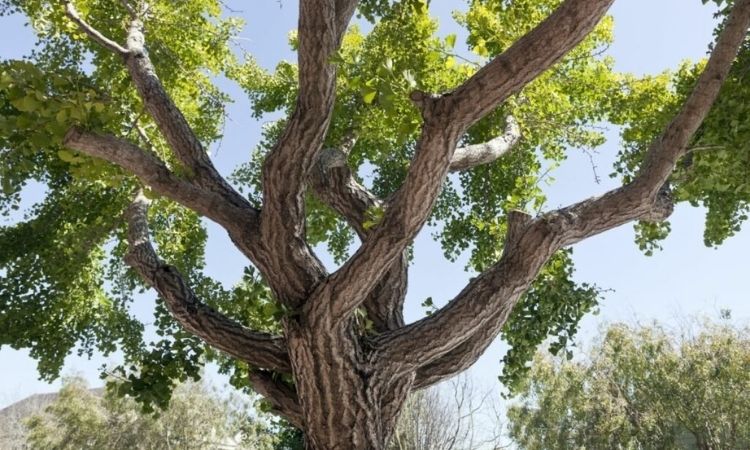
Ginkgo Leaves
The leaves of the ginkgo are unmistakably fan-shaped and long-stalked, deeply notched in the center, and lobed on the sides. They feel quite thick and coarse. In spring, the deciduous ginkgo displays light green foliage that turns golden yellow in fall.
Ginkgo flower
On a plant sit with the Ginkgo in each case either purely male or purely female flowers. Male ginkgos form long, inconspicuous catkins that spread their pollen with the wind. Female trees show their single flowers, which are on long stalks, between April and May at the time of leaf emergence.
Ginkgo fruit
Botanically, ginkgos do not form fruits, but hard seeds with a fleshy, silvery yellow seed coat. These are formed only on female trees and deter many because of their unpleasant odor of butyric acid. Therefore, almost exclusively male ginkgos are planted in gardens. In September, the 0.8 – 1.16 inches large seeds fall from the tree, the stinky seed coat rots and what remains is the edible stone core.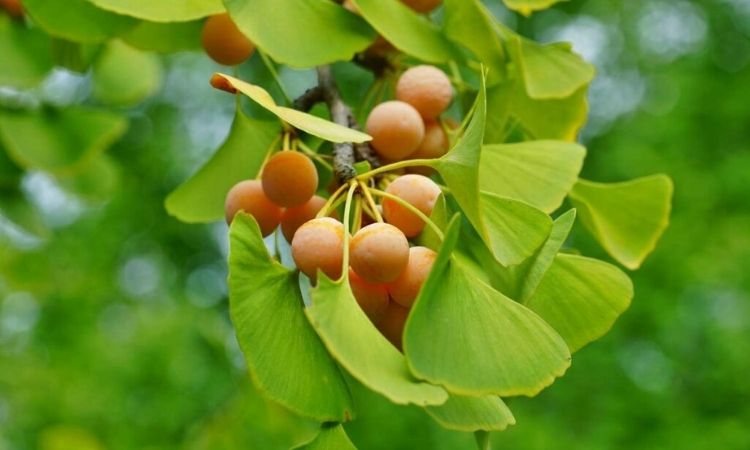
The Most Beautiful Varieties Of Ginkgo
In addition to the wild form, there are numerous ornamental forms to choose from, which are purely male and therefore do not form unpleasant-smelling fruits. However, all varieties have a sunny yellow autumn color. We present you with the most beautiful ginkgo varieties.
- Fastigiata: sparsely branched, stiffly upright variety with a growth height of up to over 65 ft and a width of up to 13 – 26 ft when old. As a young plant, this variety is rather weak-growing.
- Fastigiata Blagon: This selection originated in France around 1980. The compact and upright growing tree reaches a final height of 30 – 45 ft, in exceptional cases up to 60 ft. The cultivar is ideal as a high trunk and for confined planting sites, as it only grows 6 – 12 ft wide.
- Horizontalis: The broad, slightly pendulous habit of this Ginkgo cultivar forms a spreading, protruding crown when mature, reaching about 9 – 12 ft m in height and width.
- Mariken: Dwarf ginkgo with a dense, spherical crown and very weak growth of only about 10 cm per year. The final height reaches this variety already at 4 – 5 ft and up to 6 ft widths.
- Pendula: hanging ginkgo with up to 60 ft height and 45 ft width. This ornamental, vigorous ginkgo form forms a broad crown and is best planted in a solitary position.
- Princeton Sentry: Medium-sized tree to over 20 ft tall with a narrow and conical crown. The variety is resistant to air pollution and exhaust fumes, making it an ideal urban tree for greening roadsides.
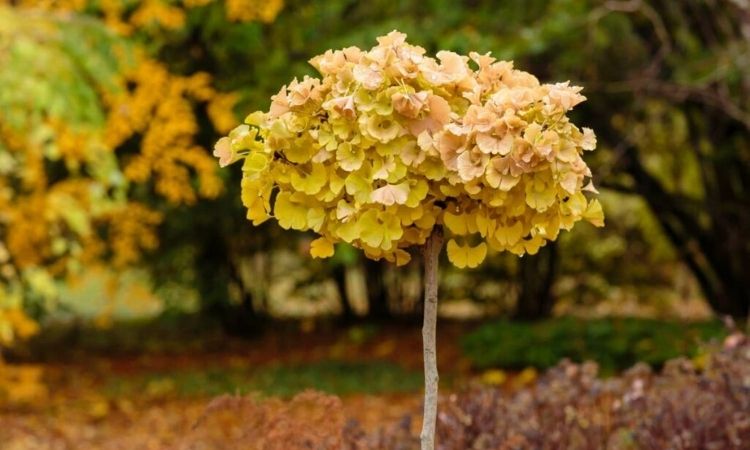
Planting Ginkgo
Ginkgos are not affected by diseases in Europe, still tolerate strong air pollution, wind, and drought. The robust and tolerant tree loves sunny to off-sunny locations. The ideal location for ginkgos is in moderately dry to moist soils with a pH between 5 and 7. Deep, well-drained, nutrient-rich substrates promote the growth of this primeval tree.
The adaptable plants can be grown as a spherical Ginkgo high trunk, bonsai, in umbrella form, or as an espalier. Depending on their growth habit and upbringing, they require different planting spacing. Stately trees in solitary position should get a distance of 18 ft from other plants in all directions. Narrow forms can be placed together up to 6 ft. See the variety description above for the exact growth sizes of each variety. The best time for planting the frost-sensitive young plants is in March before the young leaves sprout.
Planting Ginkgo In The Garden
If you would like to plant a ginkgo tree, you should first loosen and dig the soil deeply. The primeval plants root deeply and therefore require a well-prepared planting hole. Some compost can be added to the excavated soil to provide nutrients and food for microorganisms if needed. Now place the root ball of your ginkgo in the planting hole, no deeper than it was before. Then fill the planting hole with the soil mixture, compacting it slightly around the root ball and adding a watering rim. To secure the tree, drive two stakes into the ground upwind and downwind and secure your ginkgo with rope. Finally, water vigorously to flush soil to the roots.
Plant Ginkgo As Bonsai Or In A Pot
Only weak-growing ginkgo varieties, such as ‘Mariken’ are suitable for long-term keeping in a pot. Ginkgos can also be grown as ornamental bonsai trees. For planting a ginkgo tree in a pot or in a bonsai bowl, the use of high-quality planting soil. It provides the ginkgo with important nutrients during the first period after planting and retains sufficient moisture thanks to its high compost content.
To avoid waterlogging, a drainage layer of gravel, sand, or expanded clay about five centimeters high should also be filled in at the bottom of the pot. Now fill in some potting soil, place the ginkgo tree inside and add soil. Then lightly compact the substrate and then water it extensively. About every two to three years, the ginkgo should be allowed to move to a larger pot.
Care Of The Ginkgo Tree
As long as the ginkgo has not yet rooted sufficiently deep, it should be watered. If kept in pots, always ensure an adequate water supply, especially in dry and hot summers. When watering ginkgos in pots and bonsai bowls, make sure that excess water can drain off well and that waterlogging does not form. Ginkgos are undemanding garden inhabitants that require little care. The situation is different in pot culture. Here, only a limited amount of soil and thus nutrients are available. Ginkgos in planters should therefore be fertilized regularly.
Spring is the appropriate time to prune the pruning tolerant ginkgos. While the tree is still young, the crown can be thinned out and trained as desired. However, pruning is not mandatory. Ginkgos grown as bonsai, on the other hand, should always be pruned back to maintain their small form. Once a fresh long shoot with 5 – 6 leaves has formed, cut it back to two leaves. When pruning bonsai, avoid large wound areas, better regularly cut still young and thin shoots.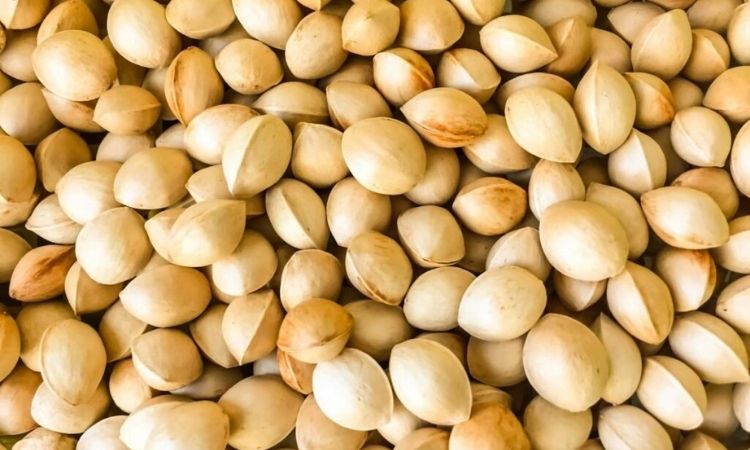
Propagate Ginkgo
Ginkgos are propagated by seeds or cuttings. When sowing ginkgo seeds, first remove the seed coat and break the dormancy by a longer cold period – because they are cold germinators. Later, the seeds are allowed to germinate at about 15 – 20 °C on a bright windowsill in nutrient-poor sowing soil. However, this can take up to two years. This can produce both male and female ginkgos. Alternatively, cut 40 – 60 in long cuttings from the fresh, soft shoot tips of an existing tree in summer. These are defoliated to the tip and placed in a sandy growing medium. For several weeks, the cuttings of the ginkgo must always be kept well moist at about 20 °C until roots have formed.
Is the ginkgo hardy?
The Ginkgo is well winter-hardy, only as a young plant it shows itself somewhat frost-sensitive. Freshly planted Ginkgo trees should therefore get good winter protection of jute or fleece in the first years. Trees in pots should be wintered annually frost-free, bright, and cool.
Effect and use
In the pharmacy preparations and tea from Ginkgo leaves are prepared. They have a circulatory and vasodilatory effect. Symptoms of depression, certain forms of dementia, headaches, tinnitus, or arterial occlusive disease can be effectively alleviated. Ginkgo and Ginseng are found together in many preparations for the increase of memory achievement. Here however only the Ginkgo leaf is used.
Only a few know that also the seeds without the bad-smelling cover are edible. From September, the ripe seeds that have fallen from the tree can be collected and freed from the seed coat. Then the hard seeds are roasted, cracked, and can be enjoyed like chestnuts. In China and Japan, ginkgo seeds are considered a delicacy and are served like nuts as a snack between meals. Traditional Chinese medicine traditionally uses extracts of the seeds together with the seed coat for asthma, tuberculosis, and kidney diseases.
Is the ginkgo poisonous?
All parts of the ginkgo are non-toxic to humans and animals. The seeds are edible, and the leaves are made into teas or herbal medicine. However, excessive consumption of fresh leaves can cause digestive problems and mild symptoms of poisoning such as nausea and headache.
The fleshy, smelly seed coat contains skin irritants and allergens. If you would like to harvest the tasty seeds, you should wear gloves when collecting and cleaning them.
If you want to raise ginkgo as a bonsai, some expertise is necessary. We explain in our article Bonsai pruning the various pruning measures so that the upbringing of the mini-tree succeeds.
